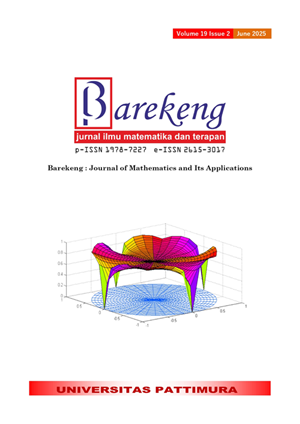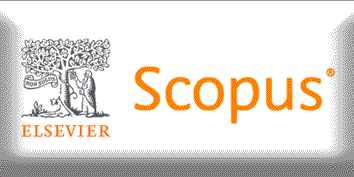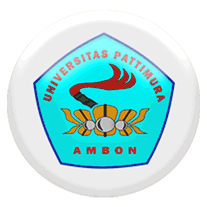ESTIMATING EARTHQUAKE MAGNITUDE USING SPATIAL INTERPOLATION WITH THE INVERSE DISTANCE WEIGHTING AND ORDINARY KRIGING APPROACH
Abstract
The West Java region is known for its high disaster vulnerability, particularly to earthquakes, due to the presence of many active faults. Based on this, information is needed as an initial step for disaster mitigation to reduce disaster risk and guarantee community safety in the West Java region, one of which is by carrying out spatial interpolation. In this study, the Inverse Distance Weighted (IDW) and Ordinary Kriging (OK) methods were used. The research sample included data on earthquake magnitude in West Java within the same coordinate range, from 01 January 2022 to 31 December 2022. This research was conducted to find out a more precise spatial interpolation method in estimating the strength of the earthquake in West Java in 2022. From the OK analysis results, the best theoretical semivariogram model was obtained, namely the Exponential model with nugget, sill and range values of 0.07, 0.12 and 11451 meters. From the results of the IDW analysis, the best power value parameter was obtained, namely 2. This research was conducted to develop a more precise spatial interpolation method for estimating earthquake strength in West Java in 2022. The OK method results indicated that most of the West Java region has the potential for earthquakes with a magnitude of around 1.5 to 4.0, while the IDW method suggested a potential magnitude of around 2.0 to 4.0. The potential for a high-magnitude earthquake is in Kp. Cileuley, Garumukti, Pamulihan District, Garut Regency, West Java. Based on the results of Holdout Cross Validation, the IDW method is the best for estimating earthquake magnitude in West Java, with a MAPE value of 17.8%. The IDW method's estimation of earthquake magnitude is superior to OK, with smaller MAPE and MAE values.
Downloads
References
Y. Syafitri, B. Bahtiar, and L. A. Didik, “ANALISIS PERGESERAN LEMPENG BUMI YANG MENINGKATKAN POTENSI TERJADINYA GEMPA BUMI DI PULAU LOMBOK,” KONSTAN: Jurnal Fisika dan Pendidikan Fisika, vol. 4, no. 2, pp. 139–146, Jan. 2020, doi: 10.20414/konstan.v4i2.43.
A. W. S. R, J. Jasruddin, and N. Ihsan, “ANALISIS REKAHAN GEMPA BUMI DAN GEMPA BUMI SUSULAN DENGAN MENGGUNAKAN METODE OMORI,” Jurnal Sains dan Pendidikan Fisika, vol. 8, no. 3, pp. 263–268, 2012.
Z. Zakaria, Ismawan, and I. Haryanto, “IDENTIFIKASI DAN MITIGASI PADA ZONA RAWAN GEMPA BUMI DI JAWA BARAT,” Bulletin of Scientific Contribution, vol. 9, no. 1, pp. 35–41, 2011.
Badan Nasional Penanggualangan Bencana, MODUL TEKNISPENYUSUNAN KAJIAN RISIKO BENCANA GEMPA BUMI. Indonesia, 2019.
A. T. Pradina and M. M. A. Pratama, “PENINGKATAN LITERASI MITIGASI BENCANA GEMPA BUMI MELALUI BOOKLET RINGKAS INOVATIF BAGI SISWA SDN WONOAYU KECAMATAN WAJAK KABUPATEN MALANG,” Jurnal pasopati, vol. 3, no. 3, pp. 168–176, 2021, [Online]. Available: http://ejournal2.undip.ac.id/index.php/pasopati
D. F. Niode, Y. D. Y. Rindengan, and S. D. S. Karouw, “GEOGRAPHICAL INFORMATION SYSTEM (GIS) UNTUK MITIGASI BENCANA ALAM BANJIR DI KOTA MANADO,” E-Journal Teknik Elektro dan Komputer, vol. 5, no. 2, pp. 14–20, 2016.
I. A. Ashari, R. A. Setiawan, and K. Nisa’, “IMPLEMENTASI WIRELESS SENSOR NETWORK: PERBANDINGAN METODE INVERSE DISTANCE WEIGHT DAN ORDINARY KRIGING UNTUK ESTIMASI KADAR GAS AMONIA PADA LINGKUNGAN PETERNAKAN,” Jurnal Teknologi Informasi dan Ilmu Komputer, vol. 9, no. 5, pp. 883–888, Oct. 2022, doi: 10.25126/jtiik.2022934394.
M. C. Safira, A. Fauzan, and M. A. S. Adhiwibawa, “INTERPOLASI POLUTAN NITROGEN DIOKSIDA (NO2) DI KOTA YOGYAKARTA DENGAN PENDEKATAN ORDINARY KRIGING DAN INVERSE DISTANCE WEIGHTED,” Jurnal Aplikasi Statistika & Komputasi Statistik, vol. 14, no. 2, pp. 55–66, 2022.
A. Sekulić, M. Kilibarda, G. B. M. Heuvelink, M. Nikolić, and B. Bajat, “RANDOM FOREST SPATIAL INTERPOLATION,” Remote Sens (Basel), vol. 12, no. 10, p. 1687, May 2020, doi: 10.3390/rs12101687.
Q. Hu, Z. Li, L. Wang, Y. Huang, Y. Wang, and L. Li, “RAINFALL SPATIAL ESTIMATIONS: A REVIEW FROM SPATIAL INTERPOLATION TO MULTI-SOURCE DATA MERGING,” Water (Basel), vol. 11, no. 3, p. 579, Mar. 2019, doi: 10.3390/w11030579.
Q. M. Ajaj, M. A. Shareef, N. D. Hassan, S. F. Hasan, and A. M. Noori, “GIS BASED SPATIAL MODELING TO MAPPING AND ESTIMATION RELATIVE RISK OF DIFFERENT DISEASES USING INVERSE DISTANCE WEIGHTING (IDW) INTERPOLATION ALGORITHM AND EVIDENTIAL BELIEF FUNCTION (EBF)(CASE STUDY: MINOR PART OF KIRKUK CITY, IRAQ),” Int. J. Eng. Technol, vol. 7, no. 4, pp. 185–191, 2018.
B. N. Ruchjana, A. N. Falah, and A. S. Abdullah, “APPLICATION OF THE ORDINARY KRIGING METHOD FOR PREDICTION OF THE POSITIVE SPREAD OF COVID-19 IN WEST JAVA,” J Phys Conf Ser, vol. 1722, no. 1, p. 012026, Jan. 2021, doi: 10.1088/1742-6596/1722/1/012026.
T. Gia Pham, M. Kappas, C. Van Huynh, and L. Hoang Khanh Nguyen, “APPLICATION OF ORDINARY KRIGING AND REGRESSION KRIGING METHOD FOR SOIL PROPERTIES MAPPING IN HILLY REGION OF CENTRAL VIETNAM,” ISPRS Int J Geoinf, vol. 8, no. 3, p. 147, Mar. 2019, doi: 10.3390/ijgi8030147.
P. Qiao, M. Lei, S. Yang, J. Yang, G. Guo, and X. Zhou, “COMPARING ORDINARY KRIGING AND INVERSE DISTANCE WEIGHTING FOR SOIL AS POLLUTION IN BEIJING,” Environmental Science and Pollution Research, vol. 25, no. 16, pp. 15597–15608, Jun. 2018, doi: 10.1007/s11356-018-1552-y.
P. Kumar, B. Rao, A. Burman, S. Kumar, and P. Samui, “SPATIAL VARIATION OF PERMEABILITY AND CONSOLIDATION BEHAVIORS OF SOIL USING ORDINARY KRIGING METHOD,” Groundw Sustain Dev, vol. 20, p. 100856, Feb. 2023, doi: 10.1016/j.gsd.2022.100856.
A. Lamamra, D. L. Neguritsa, and M. Mazari, “GEOSTATISTICAL MODELING BY THE ORDINARY KRIGING IN THE ESTIMATION OF MINERAL RESOURCES ON THE KIESELGUHR MINE, ALGERIA,” IOP Conf Ser Earth Environ Sci, vol. 362, no. 1, p. 012051, Nov. 2019, doi: 10.1088/1755-1315/362/1/012051.
E. Kostopoulou, “APPLICABILITY OF ORDINARY KRIGING MODELING TECHNIQUES FOR FILLING SATELLITE DATA GAPS IN SUPPORT OF COASTAL MANAGEMENT,” Model Earth Syst Environ, vol. 7, no. 2, pp. 1145–1158, Jun. 2021, doi: 10.1007/s40808-020-00940-5.
R. Yendra and R. R. Risman, “PENERAPAN METODE ORDINARY KRIGING PADA PENDUGAAN KRIMINALITAS DI KOTA PEKANBARU RIAU,” Jurnal Sains Matematika dan Statistika, vol. 5, no. 1, 2019.
G. Rozalia, H. Yasin, and D. Ispriyanti, “PENERAPAN METODE ORDINARY KRIGING PADA PENDUGAAN KADAR NO2 DI UDARA (STUDI KASUS: PENCEMARAN UDARA DI KOTA SEMARANG),” Jurnal Gaussian, vol. 5, no. 1, pp. 113–121, 2016, [Online]. Available: http://ejournal-s1.undip.ac.id/index.php/gaussian
N. L. Humairah and A. Fauzan, “SPATIAL INSIGHTS INTO EARTHQUAKE STRENGTH: A SULAWESI CASE STUDY USING ORDINARY AND ROBUST KRIGING METHODS,” BAREKENG: Jurnal Ilmu Matematika dan Terapan, vol. 18, no. 2, pp. 1283–1296, May 2024, doi: 10.30598/barekengvol18iss2pp1283-1296.
K. Krivoruchko, “EMPIRICAL BAYESIAN KRIGING IMPLEMENTED IN ARCGIS GEOSTATISTICAL ANALYST,” 2012.
R. T. Oktaviani, “CARBON MONOOXIDE (CO) ESTIMATION OF AIR POLLUTION IN SURABAYA USING UNIVERSAL KRIGING METHOD,” Final Task, Institut Teknologi Sepuluh Nopember, Surabaya, 2015.
G. Rozalia, H. Yasin, and D. Ispriyanti, “PENERAPAN METODE ORDINARY KRIGING PADA PENDUGAAN KADAR NO 2 DI UDARA (STUDI KASUS: PENCEMARAN UDARA DI KOTA SEMARANG),” Jurnal Gaussian, vol. 5, no. 1, pp. 113–121, 2016, [Online]. Available: http://ejournal-s1.undip.ac.id/index.php/gaussian
E. Respatti, R. Goejantoro, and S. Wahyuningsih, “COMPARISON OF ORDINARY KRIGING AND INVERSE DISTANCE WEIGHTED METHODS FOR ESTIMATION OF ELEVATIONS USING TOPOGRAPHIC DATA (CASE STUDY: FMIPA UNIVERSITY OF MULAWARMAN’S TOPOGRAPHIC),” Jurnal EKSPONENSIAL, vol. 5, no. 2, pp. 163–170, 2014.
J. M. Pasaribu, N. Suryo, H. P. Pemanfaatan, and P. Jauh, “COMPARISON OF DEM SRTM INTERPOLATION TECHNIQUES USING INVERSE DISTANCE WEIGHTED (IDW), NATURAL NEIGHBOR AND SPLINE METHOD,” Jurnal Penginderaan Jauh, vol. 9, no. 2, pp. 126–139, 2012.
H. Purnomo, “APLIKASI METODE INTERPOLASI INVERSE DISTANCE WEIGHTING DALAM PENAKSIRAN SUMBERDAYA LATERIT NIKEL (STUDI KASUS DI BLOK R, KABUPATEN KONAWE-SULAWESI TENGGARA),” Jurnal Ilmiah Bidang Teknologi, ANGKASA, vol. x, no. 1, pp. 49–60, 2018.
E. Woschnagg and J. Cipan, EVALUATING FORECAST ACCURACY. University of Vienna, 2004.
Badan Nasional Penanggulangan Bencana, KAJIAN RISIKO BENCANA NASIONAL PROVINSI JAWA BARAT 2022-2026. Indonesia, 2021.
I. Haryanto, E. Sukiyah, N. N. Ilmi, Y. A. Sendajaja, and E. Sunardi, “TECTONICS ACTIVITY AND VOLCANISM INFLUENCE TO THE GARUT AND LELES BASINS CONFIGURATION AND THE IMPLICATION ON ENVIRONMENTAL GEOLOGY,” International Journal of Science and Research (IJSR), vol. 6, no. 1, pp. 2287–2292, Jan. 2017, doi: 10.21275/art20164646.
Copyright (c) 2025 Fitri Amalia, Achmad Fauzan

This work is licensed under a Creative Commons Attribution-ShareAlike 4.0 International License.
Authors who publish with this Journal agree to the following terms:
- Author retain copyright and grant the journal right of first publication with the work simultaneously licensed under a creative commons attribution license that allow others to share the work within an acknowledgement of the work’s authorship and initial publication of this journal.
- Authors are able to enter into separate, additional contractual arrangement for the non-exclusive distribution of the journal’s published version of the work (e.g. acknowledgement of its initial publication in this journal).
- Authors are permitted and encouraged to post their work online (e.g. in institutional repositories or on their websites) prior to and during the submission process, as it can lead to productive exchanges, as well as earlier and greater citation of published works.






1.gif)



